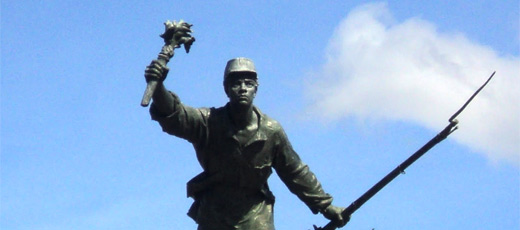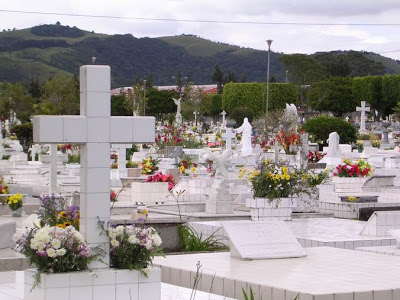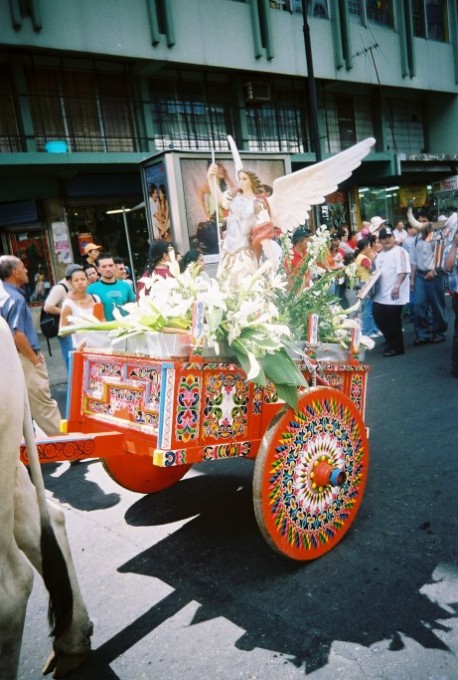New Year’s Day (January
1). For most Costa Ricans, it’s time to head to the beaches, no matter how you
get there. Whether you’re staying in expensive beach resorts or camping on the
beach itself, it’s a time to spend with friends and family doing a lot of eating
and drinking. One of the most popular drinks is Costa Rica’s famous beer called
Imperial. For those that choose not to head to the coast, there are still
plenty of things to do inland, namely huge fireworks displays. And of course, Costa Ricans also do
their New Year’s Resolutions as well.
Maundy Thursday
(varies). Pretty much the entire week of Holy Week is one big celebration for
most people. Many churches hold several special services during Holy Week.
Maundy Thursday, also called Holy Thursday, is commonly celebrated with the
institution of Holy Communion. It’s common for re-enactments to go on
throughout this week. During this time starting the night before Maundy
Thursday, bars and liquor stores close for the mandatory dry laws that take place
until after Easter.
Good Friday (varies). Special
services are held, and stories about the arrest and trials of Jesus are read.
It’s a common tradition among Catholics to not eat meat during Lent, so seafood
is a common substitution. Many television stations will also run Easter themed
movies as well. It’s also pretty common to make empanadas with the honey from a
fruit called a chiverre (a watermelon-sized fruit related to a squash.)
Easter Monday (varies). After
the hustle and bustle of Easter, which is oftentimes started with church
services and ended with local street festivals filled with food vendors, music,
dancing and all sorts of other community events. Easter Monday is the beginning of what is called by some as
Bright Week, the week after Holy Week, the week after Jesus’ resurrection.
Juan Santamaría Day
(April 11). Considered a national hero, this holiday is celebrated on the
anniversary of his death. American
William Walker was a lawyer, adventurer, and filibusterer (basically someone who
goes on unauthorized military missions to foreign countries with the purpose of
supporting some sort of political action). He had went to Nicaragua and had taken
over, declaring himself as president for a short term and was working his way
towards taking over Costa Rica as well. The Costa Ricans weren’t having this,
so this drummer boy in the Army, Juan Santamaría, volunteered to go to a hostel
and set it on fire, thought to be a decisive maneuver by the higher-ups – he
went only on the stipulation that his mother will be taken care of if he lost
his life in the process. It’s this act of bravery that is commemorated
annually.
Labor Day (May 1). Costa
Ricans celebrate Labor Day with parades, street festivals, marches, and eating
traditional food. Schools and businesses are closed for the day to celebrate.
Like many other countries, it’s also a time for the State of the Union address
by the president to the people.
Anexion de Guanacaste
Day (July 25). The province of Guanacaste in the northwestern-most corner of
Costa Rica used to be part of Nicaragua. This holiday celebrates this
province’s decision to join Costa Rica in 1924. While it’s celebrated all over
the country, the largest celebrations are in the province itself: the day is
filled with street festivals, traditional food, music, dancing, and bull
fighting (the good part is that the bulls are not killed in Costa Rican bull
fighting).
Virgin of Los Angeles
Day (August 2). The Virgin of Los Angeles, or locally called La Negrita, is the
patron saint of Costa Rica. Millions of people flock to Our Lady of the Angeles
Basilica (Basílica de Nuestra Señora de los Ángeles) in the city of Cartago,
about 10 miles from the capital city of San José. Many people come and drink and/or wash themselves in the water
of the rock the basilica was built on, and many leave silver trinkets in the
shape of the body part that they would like cured.
Mother’s Day (August
15). Mother’s Day is celebrated in coordination with the Catholic holiday
Assumption (of the Blessed Virgin Mary). Mothers are given gifts such as
flowers, chocolates, taken out to their favorite restaurants and are given
other special treatments. Mothers are generally the rulers of the home, and
many also work full time out of the home as well, so on this day, the rest of
the family wants to show her that she’s appreciated. (Father’s aren’t left out:
Father’s Day is the 3rd Sunday in June – like in the US – but it’s
not an official holiday.)
Independence Day
(September 15). Unlike many other countries, Costa Rica didn’t win its
independence by means of war. It simply just declared it. So, unlike many other
countries, it’s Independence Day celebrations do not include a military parade,
since they don’t have an Army. But they do have parades honoring national
heroes, and there are street fests, music, dance, food and drink – including
the ever-favorite Imperial beer – and soccer games among other activities. The
day before Independence Day, many people including school children will take to
the streets with homemade lanterns called faroles, in honor of the first
Independence Day and the rallying for support for their independence that took
place.
Cultural Day
(October 12). Known as Columbus Day in the US, prior to 1994, it was known as
Dia de la Raza, or Day of the (Hispanic) Race. They had since changed its name
to Dia de las Culturas (Cultural Day) to celebrate their diversity of European,
African, Caribbean, and Asian heritage.
It’s usually celebrated with street festivals, bull fighting, and a lot
of good local and traditional food.
All Souls Day (November
2). Also known as Day of the Dead, Costa Ricans in general don’t celebrate it
as much as other countries do, but many Catholics take it quite seriously. On this day, many people take this time
to visit the graves of loved ones and decorate the gravesites, do basic
maintenance, and hold vigils. Some
churches may hold special services on this day as well.
Christmas Day (December
25). Even though Costa Rica never
sees snow, it’s a common decoration throughout the country, most definitely
influenced by points much farther north. There are a lot of parties, festivals,
and parades that take place around this time of year. The three main parades
are El Carnival (a lot of music and dance and showy costumes), El Tope (a
parade with dressed-up horses pulling carriages and highly decorated and
elaborately painted oxcarts), and El Destile de Luces (a parade of lights held
at night). People bring in Christmas trees a few days before Christmas, and they’re
usually painted white and are usually smaller than what we see in the US and
other countries. In Costa Rica, it’s not Santa Claus who brings the toys – it’s
the baby Jesus himself. (It seems
odd to me that a days-old baby can do so much. Here’s what my kids did: sleep,
cry, drool, nurse, poop, repeat.)
Christmas Eve is spent enjoying a fabulous meal with family, followed by
Midnight Mass. And where we have
football games here in the US, their tradition is to watch bullfighting.
Up next: art and literature







No comments:
Post a Comment